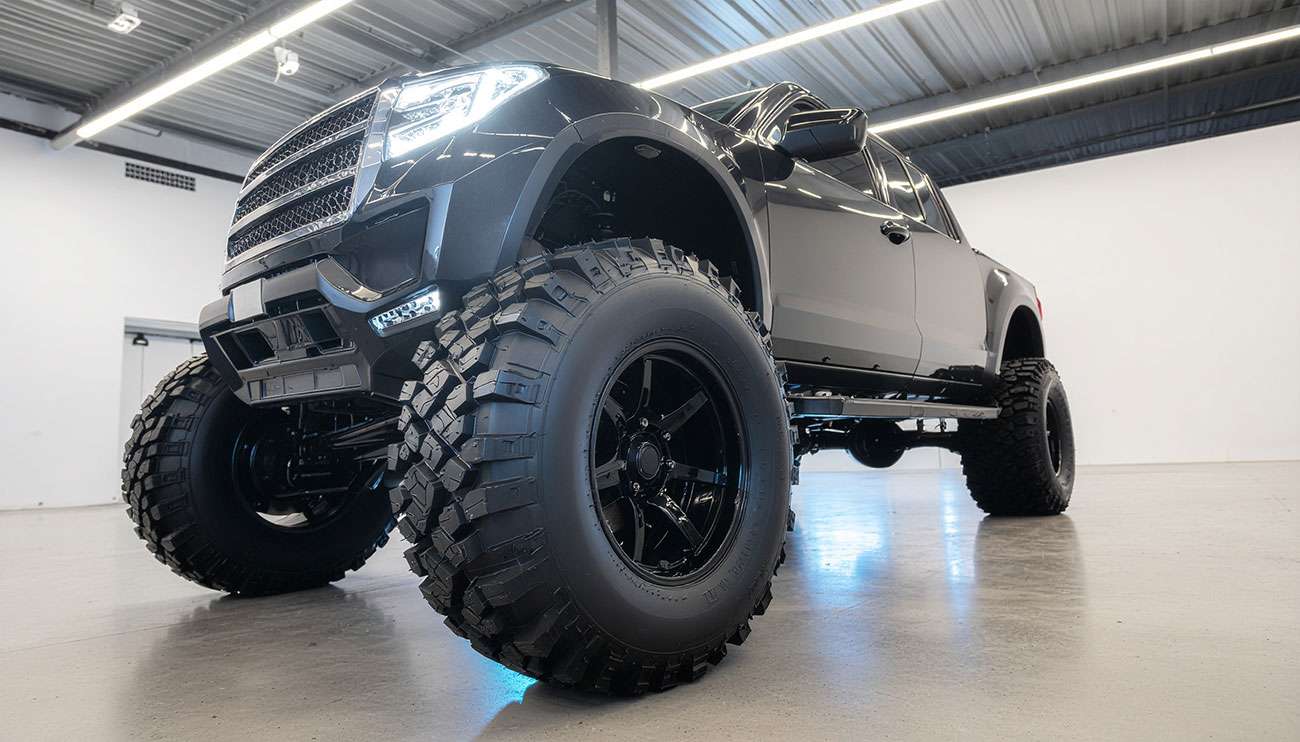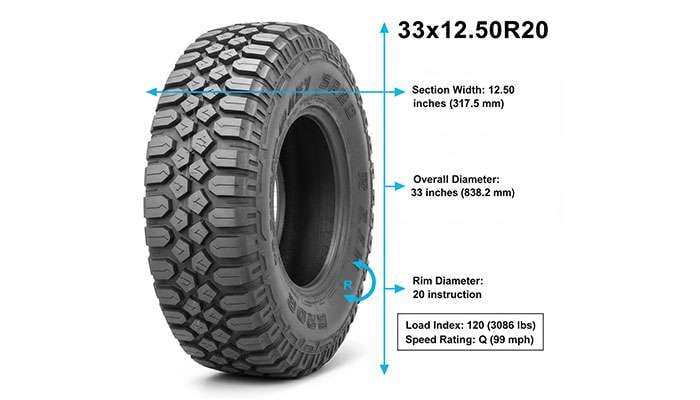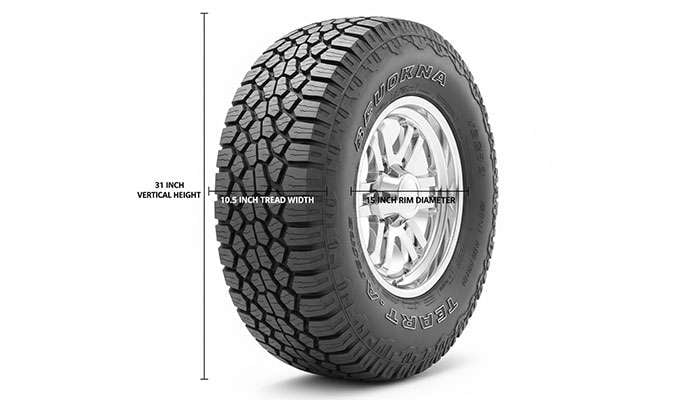
The 33x12.50R20 is one of the most popular off-road tire sizes for truck and SUV owners seeking aggressive stance and serious traction capabilities. These tires deliver impressive specifications that make them ideal for both daily driving and weekend adventures. The 33x12.50R20 measures exactly 33.0 inches in diameter, spans 12.5 inches in width, and mounts securely on 20-inch wheels. You'll get a substantial 6.5-inch sidewall height and 103.6-inch circumference, with these tires completing 611 revolutions per mile.
Proper fitment depends on understanding these exact measurements before making your purchase. The 33x12.50R20 works with wheel widths from 8.5 to 11 inches, giving you flexibility for different off-road setups and vehicle configurations. When you compare this size to alternatives like the 305/55R20, the diameter difference is minimal at just 0.1 percent, but the 33x12.50R20 offers significantly more width at 1.69 inches wider. We'll cover everything you need to know about this tire size, from metric conversions to performance impacts and detailed size comparisons with other popular options.

The numbers in 33x12.50R20 tell a specific story about tire performance and fitment. Each measurement affects how your truck handles, how it looks, and what modifications you might need.
The "33" represents total tire height from ground contact to the top tread when properly mounted. Most manufacturers target 33 inches (838.2 mm), though actual measurements can vary between brands. Some tires measure 32.76 inches while others reach 33.02 inches. These variations come from different manufacturing processes and construction methods used by each brand.
That "12.50" measurement spans the tire from sidewall to sidewall. The 33x12.50R20 delivers a full 12.5 inches (317.5 mm) of width. Real-world measurements typically range from 12.5 to 12.52 inches depending on the specific brand and model. This wide footprint creates the aggressive stance truck owners want while providing maximum ground contact for traction.
The sidewall—also called the aspect height or section height—measures approximately 6.51 inches (165.36 mm). This distance runs from the wheel rim edge to where the tread begins. You won't see this number in the tire size designation, but it's calculated from the other measurements and directly impacts ride quality and handling.
Every 33x12.50R20 tire completes roughly 611 revolutions per mile. This number determines speedometer accuracy and affects how your vehicle's gear ratios perform. Different manufacturers report values from 610 to 640 revolutions per mile based on their specific tread designs and construction methods.
These tires mount on 20-inch diameter wheels with widths between 8.5 and 11 inches. The "R" designation indicates radial construction, which is standard for modern tire manufacturing. Most tire manufacturers recommend a 10-inch rim width for optimal performance and appearance.
At Performance Plus Tire, we carry quality 33x12.50R20 tires with these exact specifications from all the leading manufacturers. Check out Performance Plus Tire's selection to find the perfect match for your truck or SUV.

Converting imperial tire sizes to metric sizing creates challenges for many truck owners, but understanding these conversions helps you compare options across different sizing systems. Metric tire designations use a different calculation method than the straightforward imperial system, making direct conversions more complex than simple math.
The closest metric equivalent for a 33x12.50R20 translates to approximately 318/60R20. This calculation uses the tire's actual width of 12.52 inches (318 mm) combined with an aspect ratio of roughly 60%. Since no tire manufacturer produces a standard 318/60R20 size, most drivers looking for metric alternatives choose the 305/55R20 as the nearest available option.
These two sizes offer remarkably similar performance characteristics with minor dimensional differences. The 305/55R20 measures 33.21 inches (843.5 mm) in diameter compared to the 33x12.50R20's 33.02 inches (838.72 mm) — just 0.19 inches (4.78 mm) or 0.6% taller. Width differences are more noticeable, with the 33x12.50R20 spanning 12.52 inches (318 mm) versus the 305/55R20's 12.01 inches (305 mm), creating a 0.51-inch (13 mm) or 4.3% difference. These variations result in 610.78 revolutions per mile for the 33x12.50R20 compared to 607.31 for the 305/55R20.
Despite similar overall heights, these sizes are not interchangeable. The 285/75R16 equals 33x11.0-16, matching the 33x12.50R20 in height but running significantly narrower and requiring a smaller 16-inch wheel. The wheel size difference alone prevents swapping between these options.
The height difference between these sizes is practically nonexistent. The 275/60R20 measures 32.99 inches while the 33x12.50R20 measures 33.02 inches — a mere 0.03 inches (0.72 mm) or 0.1% difference. Width tells a different story entirely, with the 33x12.50R20 offering 1.69 inches (43 mm) or 15.6% more width. Both sizes maintain nearly identical sidewall heights, differing by only 0.01 inches (0.36 mm).
Upgrading to 33x12.50R20 tires changes how your vehicle performs in several important ways. These aren't just numbers on paper—they affect your daily driving experience, fuel budget, and overall vehicle behavior.
Your dashboard will lie to you after installing these larger tires. Speedometer inaccuracy happens because your vehicle's computer calculates speed based on the original tire size, and bigger tires cover more ground with each rotation. Expect your speedometer to read about 3.5% slower than your actual speed. When your gauge shows 60 mph, you're really moving at 62.1 mph.
Here's a simple test: if you upgrade from 275/60R20 tires to 33x12.50R20, drive at a steady indicated 60 mph and time yourself between mile markers. You should pass them faster than 60 seconds. This difference matters for both legal compliance and accurate trip planning.
Larger tires effectively change your final drive ratio, which typically drops your engine RPM at highway speeds compared to stock tires. Think of it this way: each tire revolution covers more distance, so your engine doesn't need to work as hard to maintain cruising speed. The exact RPM reduction depends on your tire diameter, axle ratio, and transmission gearing.
Expect to visit gas stations more often. The wider 12.5-inch footprint creates more rolling resistance and aerodynamic drag than narrower alternatives. Most drivers report fuel economy drops of 1-2 MPG after switching to 33x12.50R20 tires. The extra width catches more air, the increased weight requires more power to accelerate, and the larger contact patch drags against the pavement.
The 33x12.50R20 size delivers mixed results for handling and comfort. The wider footprint provides excellent stability and cornering grip, especially during aggressive driving or off-road situations. Those tall 6.5-inch sidewalls absorb impacts better than low-profile alternatives, making rough roads more manageable.
However, some drivers notice a bumpier ride quality, particularly with aggressive tread patterns. The added unsprung weight can make your suspension feel less responsive during quick direction changes or emergency maneuvers. Consider these trade-offs based on your primary driving conditions and performance priorities.
These detailed comparisons help you understand how the 33x12.50R20 stacks up against other popular sizes. Each comparison reveals important differences that affect your vehicle's performance, clearance requirements, and overall capabilities.
The 305/50R20 measures 32.0 inches in diameter compared to the 33x12.50R20's 32.6 inches, creating a 1.8% size difference. This means your speedometer will show 61.1 mph when you're actually traveling 60 mph with the larger 33x12.50R20. The width difference is more significant—the 33x12.50R20 spans 12.6 inches versus the 305/50R20's 12.0 inches, providing 4.9% more contact patch. The taller sidewall of the 33x12.50R20 (6.3 inches versus 6.0 inches) offers better cushioning over rocks and rough terrain.
Width makes the biggest difference between these two sizes. The 275/55R20's 31.9-inch diameter creates a 3.5% height difference compared to the 33x12.50R20's 32.6 inches. This exceeds the recommended 3% limit and often requires leveling kits or other modifications to prevent tire rubbing. The width gap is dramatic—you'll gain approximately 1.5 inches of tire width with the 33x12.50R20, giving your truck a much more aggressive appearance.
Here's an interesting comparison where the 285/60R20 actually measures larger in diameter at 33.5 inches versus the 33x12.50R20's 32.6 inches—a 2.6% difference. Your speedometer will read 58.4 mph when traveling at actual 60 mph speeds with the 33x12.50R20. The 33x12.50R20 delivers significantly more width at 12.6 inches compared to the 285/60R20's 11.2 inches, providing 12.3% more ground contact.
The primary difference is the 2-inch diameter increase from 33 to 35 inches. This substantial height difference impacts ground clearance, final drive ratios, and speedometer accuracy while maintaining the same 12.5-inch width.
For quality tire options that deliver the performance characteristics discussed in these comparisons, check out Performance Plus Tire's selection of leading brand alternatives to help you find the perfect fit for your vehicle.
The 33x12.50R20 tire size offers truck and SUV owners an excellent balance of aggressive appearance and practical off-road capability. Our detailed breakdown of specifications, metric conversions, and performance impacts provides you with the essential information needed to make a confident purchase decision. The size comparisons with popular alternatives like 305/50R20 and 285/60R20 help clarify which option works best for your specific vehicle and driving requirements.
Performance considerations are important when upgrading to this size. Speedometer recalibration, fuel economy changes, and potential clearance modifications should factor into your planning. However, the benefits of improved traction, enhanced stance, and off-road capability often outweigh these considerations for enthusiasts seeking maximum performance.
At Performance Plus Tire, we understand that choosing the right tire size impacts both your vehicle's performance and your driving satisfaction. Our selection of 33x12.50R20 tires from Performance Plus Tire includes quality options from leading manufacturers, ensuring you get both the specifications and reliability you need. Whether you're tackling weekend trails or upgrading your truck's appearance for daily driving, the measurements and comparisons covered here give you the knowledge to select the perfect tires for your needs.
Understanding the exact specifications of 33x12.50R20 tires is crucial for proper fitment and performance expectations when upgrading your vehicle.
• A 33x12.50R20 tire measures exactly 33 inches in diameter, 12.5 inches wide, with a 6.5-inch sidewall height and fits 20-inch wheels.
• The metric equivalent is approximately 318/60R20, with 305/55R20 being the closest available alternative size.
• Switching to these tires causes 3.5% speedometer error and typically reduces fuel economy by 1-2 MPG due to increased weight and rolling resistance.
• These tires provide wider stance and better off-road traction but may require vehicle modifications to prevent rubbing issues.
• Compared to stock sizes like 275/60R20, the 33x12.50R20 offers nearly identical diameter but significantly more width for aggressive appearance.
When considering this tire size, factor in the performance trade-offs including speedometer recalibration needs, potential fuel economy reduction, and possible vehicle modifications required for proper clearance.
The closest metric equivalent to a 33x12.50R20 tire is approximately 318/60R20. However, since this exact size doesn't exist in the market, 305/55R20 is often considered the nearest available alternative.
The 33x12.50R20 and 275/60R20 tires have nearly identical overall diameters, differing by only 0.03 inches. However, the 33x12.50R20 is significantly wider, with a 1.69-inch difference in width.
Upgrading to 33x12.50R20 tires typically results in a decrease in fuel efficiency, with real-world reports indicating drops of 1-2 MPG. This is due to increased rolling resistance, greater tire weight, and increased aerodynamic drag.
Installing 33x12.50R20 tires causes the speedometer to read approximately 3.5% lower than the actual speed. For example, when the speedometer shows 60 mph, the vehicle is actually traveling at about 62.1 mph.
A 33x12.50R20 tire has an overall diameter of 33.0 inches (838.2 mm), a section width of 12.5 inches (317.5 mm), and a sidewall height of approximately 6.5 inches (165.1 mm). It's designed to fit on 20-inch diameter wheels with rim widths ranging from 8.5 to 11 inches.